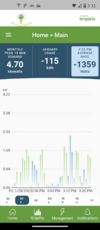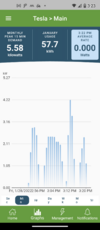Now that I'm on solar with NEM2, I believe I'll be paying "non-bypassable charges" when charging at night using power generated during the day. These are small, but they add up - I'm calculating about $180 a year for 25,000 miles.
One way to avoid this is to charge during the day and constantly adjust the charging rate to match the solar generation. But that's a lot of work, so I've been looking for a "set and forget" solution.
There are some EV chargers (e.g. from Emporia, Wallbox, and probably others) that can supposedly charge a car using the excess power that would otherwise be sent to the grid. They do this by measuring the output through the electric main or communicating with a PG&E Smart Meter and adjusting the power delivered through the EV charger to keep the net exported power at around zero.
These seem like they would save money (by avoiding non-bypassable charges), and they'd also avoid using/straining the grid (which proponents of "NEM3" claim is a big deal that needs to be paid for).
Does anyone have experiences with these types of chargers or this type of charging strategy?
If grid usage is such a big deal (see discussion about NEM3), I also wonder why this this charging strategy isn't promoted more, and why there aren't incentives to install them.
One way to avoid this is to charge during the day and constantly adjust the charging rate to match the solar generation. But that's a lot of work, so I've been looking for a "set and forget" solution.
There are some EV chargers (e.g. from Emporia, Wallbox, and probably others) that can supposedly charge a car using the excess power that would otherwise be sent to the grid. They do this by measuring the output through the electric main or communicating with a PG&E Smart Meter and adjusting the power delivered through the EV charger to keep the net exported power at around zero.
These seem like they would save money (by avoiding non-bypassable charges), and they'd also avoid using/straining the grid (which proponents of "NEM3" claim is a big deal that needs to be paid for).
Does anyone have experiences with these types of chargers or this type of charging strategy?
If grid usage is such a big deal (see discussion about NEM3), I also wonder why this this charging strategy isn't promoted more, and why there aren't incentives to install them.




